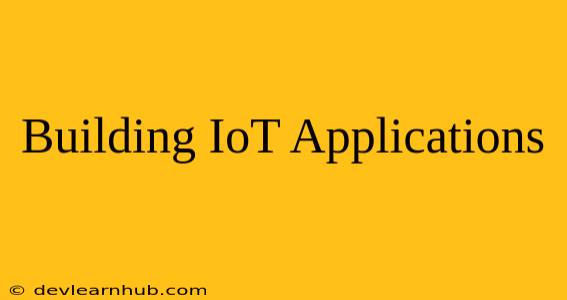Introduction
The Internet of Things (IoT) is rapidly transforming the world around us, connecting everyday objects to the internet and enabling them to collect, exchange, and act upon data. This interconnected network is driving innovation across industries, from smart homes and cities to healthcare and manufacturing. As the IoT landscape continues to evolve, the demand for skilled developers who can build innovative and robust applications is growing exponentially.
This comprehensive guide aims to equip you with the knowledge and skills necessary to embark on your journey into IoT application development. We will delve into the fundamental concepts, key technologies, and practical steps involved in building successful IoT solutions.
Understanding the Fundamentals of IoT
What is IoT?
At its core, the IoT refers to the network of physical devices, vehicles, home appliances, and other objects embedded with sensors, software, and network connectivity. These devices communicate and interact with each other and with central systems, enabling real-time data collection, analysis, and control.
Key Components of an IoT System
An IoT system typically consists of the following components:
- Sensors: Gather data from the physical world, such as temperature, pressure, light, and motion.
- Actuators: Respond to data received from sensors by controlling physical processes, like opening a valve or turning on a light.
- Connectivity: Enables communication between devices and the cloud, using technologies like Wi-Fi, Bluetooth, cellular networks, and LoRaWAN.
- Data Processing and Analysis: Collects, stores, and analyzes data from devices to extract insights and generate actionable information.
- Applications: Provide user interfaces, dashboards, and functionalities to interact with and control the IoT system.
Developing an IoT Application: A Step-by-Step Guide
Building an IoT application requires a systematic approach that involves defining the application's purpose, selecting the right technologies, and implementing the software architecture.
Step 1: Define the Application Requirements
- Identify the Problem: Start by clearly defining the problem you aim to solve with your IoT application.
- Define Use Cases: Determine how your application will be used in different scenarios, including user interactions and data flow.
- Set Objectives: Clearly define the goals and expected outcomes of your application.
- Identify Key Data Points: Determine the type of data your application needs to collect and analyze, including the frequency of data collection.
- Consider User Experience: Ensure that your application is intuitive, user-friendly, and accessible to the intended audience.
Step 2: Choose the Right Technologies
The choice of technologies depends heavily on the specific requirements of your IoT application. Some of the essential technologies include:
- Hardware:
- Microcontrollers: Devices like Arduino and Raspberry Pi offer flexibility and cost-effectiveness for prototyping and development.
- Sensors: Select sensors suitable for the data you need to collect, such as temperature sensors, pressure sensors, accelerometers, and GPS modules.
- Actuators: Choose actuators that can control physical systems based on your application's needs, such as motors, solenoids, and LEDs.
- Software:
- Operating Systems: Embedded operating systems like FreeRTOS and Contiki are designed for resource-constrained devices.
- Cloud Platforms: AWS IoT, Azure IoT Hub, and Google Cloud IoT Core provide cloud services for data storage, processing, and analytics.
- Programming Languages: C/C++ are popular for embedded systems, while Python and JavaScript are used for cloud-based development.
- Communication Protocols: Select protocols like MQTT, CoAP, and HTTP based on your application's communication requirements.
Step 3: Design the Software Architecture
A well-designed software architecture is crucial for the scalability, maintainability, and security of your IoT application.
- Layered Architecture:
- Sensor Layer: Collects and pre-processes data from sensors.
- Network Layer: Handles communication between devices and the cloud.
- Data Processing Layer: Stores, analyzes, and processes data in the cloud.
- Application Layer: Provides user interfaces, dashboards, and functionalities for interacting with the system.
- Micro-services Architecture: Decomposes the application into smaller, independent services that communicate via APIs, improving scalability and maintainability.
- Event-Driven Architecture: Enables real-time data processing and decision-making by using events triggered by sensors or other devices.
Step 4: Develop and Test the Application
- Prototype Development: Begin with a proof-of-concept prototype to validate your design and test core functionalities.
- Code Development: Write clean and well-documented code following best practices.
- Testing and Debugging: Thoroughly test your application in different environments and scenarios to identify and fix bugs.
- Security Considerations: Incorporate security measures throughout the development process to protect your application from threats.
- Authentication and Authorization: Secure access to your system and protect sensitive data.
- Data Encryption: Secure communication between devices and the cloud.
- Secure Firmware Updates: Implement mechanisms for updating firmware securely.
Step 5: Deploy and Monitor the Application
- Deployment: Deploy your application in the target environment, ensuring proper configuration and connectivity.
- Monitoring and Maintenance: Continuously monitor the application's performance, identify issues, and implement updates and maintenance as needed.
- Scalability and Performance Optimization: Scale your application to accommodate increasing data volumes and user demands.
Key Considerations for Building Successful IoT Applications
- Data Security: Protect user privacy and sensitive data from unauthorized access.
- Scalability: Design your application to handle increasing data volumes and user interactions.
- Performance Optimization: Ensure fast data processing and minimal latency for real-time applications.
- Interoperability: Design your application to work seamlessly with different devices and platforms.
- Cost-Effectiveness: Select technologies and resources that are cost-effective and meet your budget constraints.
- User Experience: Prioritize user-friendly interfaces, clear instructions, and intuitive interactions.
Conclusion
Building IoT applications presents a unique set of challenges and opportunities. By understanding the fundamentals, adopting a systematic approach, and leveraging the right technologies, you can develop innovative and impactful solutions that transform industries and improve our lives. Remember to prioritize data security, scalability, performance, and user experience to ensure the success of your IoT applications.
